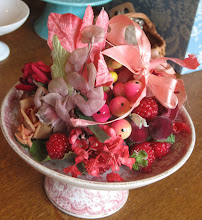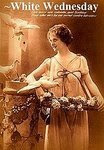 Meet the Johnsons of Jamestown, New York. In addition to my grandmother Ruth on Peter John's lap, see Ambert, Stanley, and Rudolph (Grandma's twin brother) on my great-grandmother Sanna Matilda's lap. Standing in back are Florence and Elmer. Both my great-grandparents had been to the United States and worked before they eventually left Smaland and immigrated with Elmer, Florence, and Ambert. Stanley and the twins were born in Jamestown, where they made a new life with other Swedes.
Meet the Johnsons of Jamestown, New York. In addition to my grandmother Ruth on Peter John's lap, see Ambert, Stanley, and Rudolph (Grandma's twin brother) on my great-grandmother Sanna Matilda's lap. Standing in back are Florence and Elmer. Both my great-grandparents had been to the United States and worked before they eventually left Smaland and immigrated with Elmer, Florence, and Ambert. Stanley and the twins were born in Jamestown, where they made a new life with other Swedes.When Stanley was elderly, he gave me his mother's papers. He and his late wife had never had children and he knew I was interested in history, so he offered them to me. Almost everything was in Swedish, but I had taken one year of Swedish in college and wanted to give it a try. Several letters begin, "Min kara liten Tilda" (My dear little Tilda).
Recently I looked at all of her papers and marveled at how beautiful they seemed. Most of the papers were letters she received, but some of the items were things often described as "ephemera." She had two small engraved invitations to weddings in San Francisco. The couples were Swedish; Matilda had worked as a maid in SF before she immigrated. She also saved several small cards bearing congratulations-for what, I don't know. I wanted to use these in artwork, but I wasn't sure how.
I decided to copy these on my home printer and work with the copies to preserve the integrity of the originals. I strongly encourage this, as you don't want to damage the original items (especially family pieces). Then I used Mod Podge to fasten them onto papier mache boxes. After letting them dry thoroughly overnight, I covered each box inside and out with a clear acrylic sealer. The process worked pretty well. What do you think?

It's kind of funny to think about these decorated boxes as commemorative family mementos because they're functional. You can use these on a desk, dresser, or anywhere. They hold up pretty well with use. At the same time, the boxes are conversation pieces and add a pretty touch during your day.
Do you have family papers that you have used in art? If not, think about giving it a try. It's time-consuming, but fun and well worth the effort. Lycka till!






































1 comment:
What a special project. I especially like the writing on the side of the circular box. They both came out very nicely:)
Post a Comment